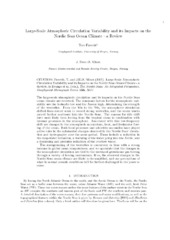Large-Scale Atmospheric Circulation Variability and its Impacts on the Nordic Seas Ocean Climate - a Review. In: The Nordic Seas: An Integrated Perspective
Chapter
Permanent lenke
https://hdl.handle.net/1956/851Utgivelsesdato
2005Metadata
Vis full innførselSamlinger
- Geophysical Institute [1198]
Sammendrag
The large-scale atmospheric circulation and its impacts on the Nordic Seas ocean climate are reviewed. The dominant factors for the atmospheric variability are the Icelandic low and the Azores high, determining the strength of the westerlies. From the ’60s to the ’90s, the atmospheric circulation shifted from record weak to record strong westerlies, and the storm tracks moved further northeast into the Nordic Seas. The reasons for this shift have most likely been forcing from the tropical ocean in combination with internal processes in the atmosphere. Associated with this low-frequency shift are changes in the atmospheric momentum, heat, and freshwater forcing of the ocean. Both local processes and advective anomalies have played active roles in the substantial changes observed in the Nordic Seas’ circulation and hydrography over the same period. These include a reduction in the deep-water formation, a warming of the water going into the Arctic, and a freshening and probable reduction of the overflow water. The strengthening of the westerlies is concurrent in time with a strong increase in global mean temperatures, and we speculate that the changes in the atmospheric circulation are tied to the increased greenhouse gas forcing through a variety of forcing mechanisms. If so, the observed changes in the Nordic Seas ocean climate are likely to be amplified, and our perceptions of what is normal oceanic conditions will be further challenged in the years to come.
